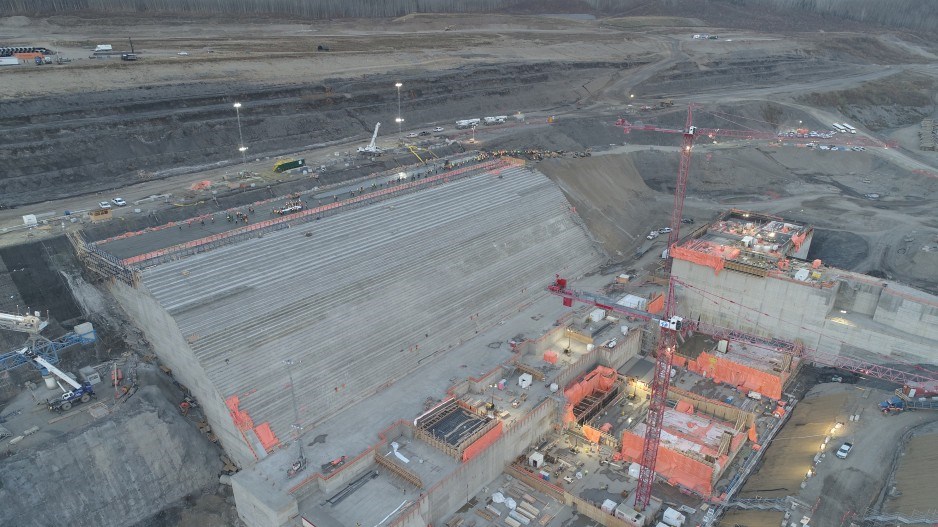Cancelling multi-billion dollar hydro-electric dam projects like Site C in B.C. and Muskrat Falls in Labrador and providing power with natural gas and wind power would still be cheaper in the long-run, even with billions in sunk costs that governments and ratepayers would have to absorb.
That’s the conclusion of a study released January 17 for the C.D. Howe Institute.
Author A.J. Goulding says in his report that cost overruns at three large-scale Canadian hydro-electric dam projects should prompt governments to consider halting the projects, or at least stand as a lesson for other governments contemplating future large-scale hydro projects.
Goulding’s analysis finds the levelized costs of the $10.7 billion Site C dam and the $8.7 billion Keeysak project in Manitoba may exceed the cost of power that could be provided through combined cycle natural gas turbine (CCGT) power plants, even with the sunk costs of cancelling the projects, and even with a $50 per tonne carbon tax.
“Currently, given where Site C is, it would be possible, in our opinion, to cancel it, defer some of the investment, replace it with cheaper and smaller-scale resources,” Goulding told Business in Vancouver.
To date, $3.2 billion has already been spent on Site C dam, according to BC Hydro. That doesn’t include the additional costs of site remediation, or penalties for breaking contracts that are already signed.
While Goulding’s report focuses mainly on replacing hydro power with natural gas power, it also mentions wind.
It points to the falling cost of installing wind power, and recommends a combination of intermittent renewables (wind) backed by dispatchable power from natural gas as being “more cost-effective.”
While that combination will likely play out in Alberta and Saskatchewan – as both provinces move to phase out coal – such a generation mix is a non-starter in B.C.
The Clean Energy Act forbids natural gas power, and requires all new power generation to come from non-emitting sources.
While Goulding’s analysis confirms what groups like Clean Energy BC argued – that wind power would be cheaper than hydro power – Clean Energy BC executive director Jae Mather said Goulding’s recommendations for natural gas power just wouldn’t work in B.C.
“You’re not going to have BC Hydro adding gas now,” Mather said. “If it was going to happen, it would have happened five, 10 years ago. Now, there’s no way. With the CleanBC plan, it’s just not going to happen.”
Given that natural gas power isn’t an option in B.C., Goulding conceded that it would be more difficult to meet the power needs from wind alone.
“If you were going to try to do it all with wind, you wouldn’t have the same capacity benefit as Site C,” he said. “So if you didn’t want to back it with natural gas you’d have to back it with batteries.”
In that case, the province might have to wait to deploy some new wind projects until the large-scale storage solutions become economic.
Blake Shaffer, an energy policy fellow at C.D. Howe, points out that, when comparing energy sources, it’s a mistake to only calculate the cost of building and delivering power.
The value of that power also needs to be considered, and in the case of wind, its value is lower than dispatchable power, and that value declines the more wind power is added to a grid.
“A little wind is fine; a lot of wind blowing at the same time can reduce its value dramatically,” he recently wrote.
Shaffer told BIV that a proper calculation would need to consider the value, not just the levelized cost of electricity (LCOE), for wind power.
“It notes wind power costs are falling but doesn’t do the economic comparison,” Shaffer said of Goulding’s analysis. “The wind replacement comparison would require proper capacity adjustments done, not a simple LCOE cost comparison.”
Goulding’s assessment would have been useful in 2017, when the BC Utilities Commission (BCUC) was reviewing the Site C dam project. But if the project was deemed too far-gone to stop in 2017, it is even more so in 2019.
After the new Green-backed NDP government took power in B.C., it referred the Site C dam project to the BC Utilities Commission (BCUC) for a review. Delays had boosted the project’s capital costs from $8.3 billion to an estimated $10.7 billion.
But cancelling the project would mean having to absorb $4 billion in sunk costs and remediation, and covering those costs would have required a 12% BC Hydro rate hike, the commission concluded. The John Horgan government therefore reluctantly decided to complete the project.
“However, careful economic analysis suggests that BC ratepayers may, in fact, end up paying more by the project continuing than they would if they simply paid off the debt already incurred and pursued an alternative path,” Goulding's study warns.
While Goulding’s analysis bolsters the arguments that David Austin – a lawyer specializing in energy for Stirling LLP – made against Site C dam, he thinks it’s too late now to call it to a halt.
“It is too late to do anything about Site C,” he said. “The only solace is that with CleanBC electricity demand should go up so much that we can develop wind and solar to blend the cost of Site C down. In other words try to minimize the cost of the mistake.”




